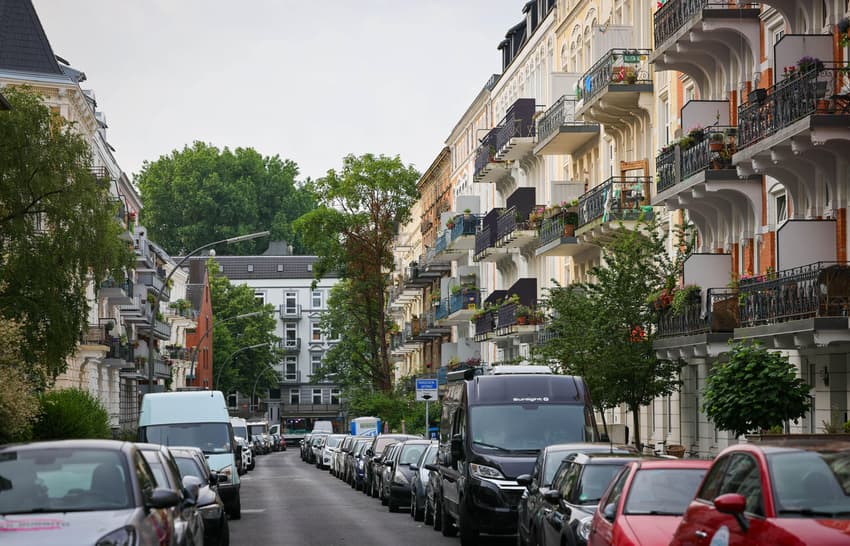Where in Germany do workers spend most of their income on rent?

In several neighbourhoods across the seven largest German cities, the monthly cold rent has now reached a point where it accounts for more than a third of the average income.
Looking to move? Find your next rental apartment here.
In Germany's bustling urban centres, the cost of renting a home has become an increasingly burdensome expense for residents.
A new study conducted by Berlin-based data provider 21st Real Estate looked at the relationship between income and rent in Germany's seven biggest cities to find out just how much of their income residents are shelling out to keep a roof over their heads.
According to their analysis, Berlin stands out as the city with the most significant disparity between net income and rental costs.
The study estimates that the average cost ratio for the entire city is a staggering 32 percent - with the situation in the Capital characterised by high cold rents and relatively modest average incomes.
In this regard, Berlin's rental cost ratio of 32 percent is on par with Munich, despite Munich's overall higher average rent prices.
This discrepancy is explained by the fact that Munich’s particularly expensive micro-locations with rental cost ratios exceeding 35 percent are also home to residents with significantly higher average incomes, averaging €57,259 per year. In contrast, the corresponding neighbourhoods in Berlin have average incomes of only €40,255 annually.
READ ALSO: REVEALED: How the cost of renting in Germany compares to home ownership
The analysis further reveals that Stuttgart ranks third with a rental cost ratio of 29 percent, followed by Frankfurt at 27 percent. Among the metropolises, Cologne is the most affordable with a ratio of 26 percent, followed by Düsseldorf and Hamburg, both at 25 percent.
However, even in these cities, many neighbourhoods are grappling with rental cost ratios exceeding 30 percent. In Hamburg, for example, rent consumes over 37.5 percent of the average income in almost all streets north of the Elbe in the Mitte and Nord districts.
Notably, the rental burden significantly eases in the suburban areas surrounding major cities. For instance, near Düsseldorf, Duisburg offers a much more affordable rental cost ratio, at just 13.4 percent.
The findings of the 21st Real Estate analysis are based on the evaluation of 271,000 online-published apartment listings and income calculations that take into account micro-locations within streets and neighbourhoods.
The data is sourced from income data provided by the market research institute GfK. It is worth noting that while the rental offers analysed are not finalised lease agreements, the high demand for housing in these urban areas means that it is very rare for landlords to offer discounts.
Comments
See Also
In Germany's bustling urban centres, the cost of renting a home has become an increasingly burdensome expense for residents.
A new study conducted by Berlin-based data provider 21st Real Estate looked at the relationship between income and rent in Germany's seven biggest cities to find out just how much of their income residents are shelling out to keep a roof over their heads.
According to their analysis, Berlin stands out as the city with the most significant disparity between net income and rental costs.
The study estimates that the average cost ratio for the entire city is a staggering 32 percent - with the situation in the Capital characterised by high cold rents and relatively modest average incomes.
In this regard, Berlin's rental cost ratio of 32 percent is on par with Munich, despite Munich's overall higher average rent prices.
This discrepancy is explained by the fact that Munich’s particularly expensive micro-locations with rental cost ratios exceeding 35 percent are also home to residents with significantly higher average incomes, averaging €57,259 per year. In contrast, the corresponding neighbourhoods in Berlin have average incomes of only €40,255 annually.
READ ALSO: REVEALED: How the cost of renting in Germany compares to home ownership
The analysis further reveals that Stuttgart ranks third with a rental cost ratio of 29 percent, followed by Frankfurt at 27 percent. Among the metropolises, Cologne is the most affordable with a ratio of 26 percent, followed by Düsseldorf and Hamburg, both at 25 percent.
However, even in these cities, many neighbourhoods are grappling with rental cost ratios exceeding 30 percent. In Hamburg, for example, rent consumes over 37.5 percent of the average income in almost all streets north of the Elbe in the Mitte and Nord districts.
Notably, the rental burden significantly eases in the suburban areas surrounding major cities. For instance, near Düsseldorf, Duisburg offers a much more affordable rental cost ratio, at just 13.4 percent.
The findings of the 21st Real Estate analysis are based on the evaluation of 271,000 online-published apartment listings and income calculations that take into account micro-locations within streets and neighbourhoods.
The data is sourced from income data provided by the market research institute GfK. It is worth noting that while the rental offers analysed are not finalised lease agreements, the high demand for housing in these urban areas means that it is very rare for landlords to offer discounts.
Join the conversation in our comments section below. Share your own views and experience and if you have a question or suggestion for our journalists then email us at [email protected].
Please keep comments civil, constructive and on topic – and make sure to read our terms of use before getting involved.
Please log in here to leave a comment.